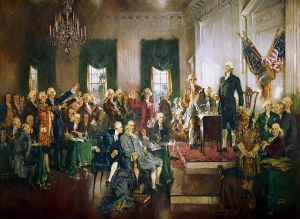Chapter 5: Constitutional and Criminal Law in the U.S. Criminal Justice System

Overview

Understanding how the various components of the U.S. criminal justice system work together—or sometimes do not work at all— to ensure a fair, equitable, and impartial judicial system is much like trying to assemble an enormous jigsaw puzzle. Hopefully, the many different pieces will come together to form a complete picture; however, finding where and how each piece fits into the big picture can be tedious, time-consuming, and challenging. The various chapters of this book offer definitions and explanations as to how the many components of the U.S. criminal justice system (law enforcement, courts, corrections, law) fit together.
Chapter 5 explores one of the common overarching aspects of the U.S. criminal justice system—the law. Various bodies of law exist; however, not every body of law affects or is part of the U.S. criminal justice system. Chapter 5 focuses explicitly on constitutional law and criminal law, the two bodies of law most relevant to the U.S. criminal justice system. This chapter offers insight into how constitutional law serves as the framework for the entire U.S. criminal justice system to balance individuals’ rights against the government’s duties and responsibilities. The chapter also addresses how criminal law is created and enforced in an effort to define criminal offenses, set boundaries for societal behavior, prevent harm, protect property, and maintain public order.
Next, Chapter 5 addresses recent trends in constitutional and criminal law and offers some insight into the ever-changing dynamics of constitutional and criminal law. Chapter 5 concludes by identifying potential law-related employment positions, explaining the requirements for obtaining these positions, and addressing the protocols and processes involved in pursuing these positions.
Objectives
- Explain the concept of “body of law,” define the various bodies of law applicable within the United States, identify which two bodies of law are most relevant to the U.S. criminal justice system, and explain why they are the most relevant.
- Describe the U.S. Constitution’s origin, structure, and purpose, including the concept of checks and balances between the three branches of government.
- Describe the relationship between constitutional law and criminal law and explain which specific rights and privileges under the Constitution and the Bill of Rights are relevant during the investigation and prosecution of criminal offenses.
- Compare and contrast the concepts of rule of law and principle of legality and explain why these concepts are a critical part of the U.S. criminal justice system.
- Compare and contrast the concepts of substantive law and procedural law and explain how these two concepts operate within the U.S. criminal justice system.
- Identify and define the various classifications of statutory criminal offenses, the most common substantive criminal offenses, and the defenses to and limitations on the prosecution of these offenses.
- Describe the elements of criminal law and identify the specific components of the “crime formula” involved in defining what constitutes a criminal offense.
- Explain the criminal law-related concepts of inchoate offenses, strict liability, lesser included offense, and the felony murder rule.
- Identify four broad categories of evolving developments in constitutional and criminal law within the U.S. criminal justice system and provide examples of each of these four categories.
- Identify law-related employment opportunities, the specific duties and responsibilities of these positions, the requirements for obtaining employment, and describe the application protocol and processes for these positions.
Key Terms
- Actus reus
- Attendant circumstances
- Bill of rights
- Body of law
- Burden of proof
- Checks and balances
- Common law
- Complicity
- Constitutional law
- Crimes against persons
- Crimes against property
- Criminal law
- Double jeopardy
- Due process clause
- Elements of crimes
- Equal protection clause
- Exclusionary rule
- Ex post facto
- Felony
- Felony murder rule
- Inchoate offenses
- Infraction
- Jurisdiction
- Lesser included offense
- Mala in se
- Mala prohibitum
- Mens rea
- Miranda v. Arizona
- Misdemeanor
- Principle of legality
- Probable cause
- Procedural criminal law
- Rule of law
- Selective prosecution
- Self-incrimination
- Stop and frisk (Terry stop)
- Substantive criminal law
Attributions
- Chapter opening image: Untitled by Howard Chandler Christy in the public domain; This image is a work of an employee of the Architect of the Capitol, taken or made as part of that person’s official duties. As a work of the U.S. federal government, all images created or made by the Architect of the Capitol are in the public domain in the United States.
- Figure 5.1: image released under the Pexels License
A collection of all the law relating to a specific legal topic, e.g., criminal law, constitutional law, and military law.
The body of law deriving from the U.S. Constitution and dealing primarily with governmental powers, civil rights, and civil liberties.
The body of law defining offenses against the community at large, regulating how suspects are investigated, charged and tried, and establishing punishments for convicted offenders. Criminal law consists of substantive criminal law and procedural criminal law. Also called Penal Law.
The federal Constitution establishes the three branches of government—the legislative (Congress), the executive (President), and the judicial (Courts) with each branch having a different role. The Constitution sets out the various "checks and balances" each branch of government exerts over the other two branches.
The first 10 amendments to the U.S. Constitution.
The doctrine that every person is subject to the ordinary law within the jurisdiction; the equal subordination of all citizens and classes to the ordinary law of the land.
Strict adherence to law, prescription, or doctrine; the quality of being legal. The principle that a person may not be prosecuted under a criminal law that has not been previously published.
Also termed a substantive crime, a crime that is complete in itself and is not dependent on another crime for one of its elements.
The rules governing the mechanisms under which crimes are investigated, prosecuted, adjudicated, and punished. It includes the protection of an accused person's constitutional rights.
A step toward the commission of another crime, the step in itself being serious enough to merit punishment. The three inchoate offenses are attempt, conspiracy, and solicitation.
Circumstances where all of the elements of one crime are also included in a different crime. For example, the crime of trespass is an LIO of burglary.
The doctrine holding that any death resulting from the commission or attempted commission of a felony is murder. Most states restrict this rule to inherently dangerous felonies such as rape, arson, robbery, and burglary.

